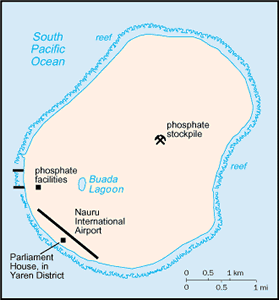The Geography of Nauru
The Geography of Nauru
Nauruan Geography
Location: Oceania, island in the South Pacific Ocean, south of the Marshall Islands
Geographic coordinates: 0 32 S, 166 55 E
Map references: Oceania
Area: total: 21 sq km land: 21 sq km water: 0 sq km
Area - comparative: about 0.1 times the size of Washington, DC
Land boundaries: 0 km
Coastline: 30 km
Maritime claims: territorial sea: 12 nm contiguous zone: 24 nm exclusive economic zone: 200 nm
Climate: tropical with a monsoonal pattern; rainy season (November to February)
Terrain: sandy beach rises to fertile ring around raised coral reefs with phosphate plateau in center
Elevation extremes: lowest point: Pacific Ocean 0 m highest point: unnamed location along plateau rim 61 m
Natural resources: phosphates, fish
Land use: arable land: 0% permanent crops: 0% other: 100% (2005)
Irrigated land: NA
Natural hazards: periodic droughts
Environment - current issues: limited natural fresh water resources, roof storage tanks collect rainwater, but mostly dependent on a single, aging desalination plant; intensive phosphate mining during the past 90 years - mainly by a UK, Australia, and NZ consortium - has left the central 90% of Nauru a wasteland and threatens limited remaining land resources
Environment - international agreements: party to: Biodiversity, Climate Change, Climate Change-Kyoto Protocol, Desertification, Hazardous Wastes, Law of the Sea, Marine Dumping, Ozone Layer Protection, Whaling signed, but not ratified: none of the selected agreements
Geography - note: Nauru is one of the three great phosphate rock islands in the Pacific Ocean - the others are Banaba (Ocean Island) in Kiribati and Makatea in French Polynesia; only 53 km south of Equator


